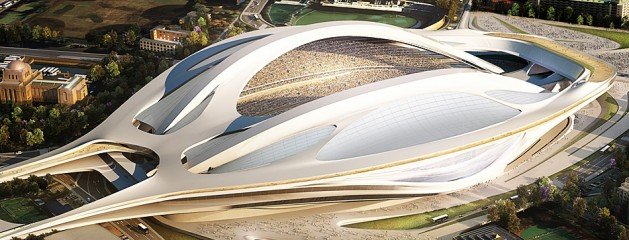Reconstruction work on the National Stadium, which was the 1964 Tokyo Olympics‘ main stadium and will be so again for the 2020 Games, will get under way in summer next year.
The renovations will be made partly out of concerns about its quake-resistance and capacity. Work is expected to be completed in the spring of 2019.
The renovated National Stadium will seat about 80,000 people — or some 25,000 more than it can now accommodate — and feature nine-lane running tracks. Moreover, stadium will be designed so that the stands can be moved closer to the pitch for soccer and rugby games. Concerts and other cultural events can also be held at the facility with retractable-roof, which will furthermore host a sports museum and commercial complex.
Prior to the Tokyo Olympics and Paralympics, the refreshed National Stadium will be used as the site for the 2019 Rugby World Cup. The call for designs for the retrofit attracted 46 entries from architects all over the world, with the winning proposal submitted by Zaha Hadid of Iraq. The streamlined shape of her design expresses the dynamism of sports.
Tokyo had planned to build a new facility in the Harumi seafront district of Chuo Ward as the main stadium when it bid to host the 2016 Olympics and Paralympics. However, the International Olympic Committee called into question the safety of the area, pointing out that it was bordered by water on three sides. In response, Tokyo chose to refurbish the National Stadium as part of its 2020 bid. How the national and metropolitan governments choose to share the estimated 130 billion yen cost of the stadium, however, will likely emerge as a point of contention.
Other key venues include the Yoyogi National Gymnasium in Shibuya Ward and Nippon Budokan in Chiyoda Ward.
The Yoyogi National Gymnasium, where swimming events were held during the 1964 Olympics, will be the site for handball games at the 2020 Games. The late architect Kenzo Tange designed the facility. The structure has a hanging roof, meaning there is not a single column inside the building.
Nippon Budokan, whose roof was designed after Mount Fuji, was built as the site for judo matches in the 1964 Olympics at a total cost of some 2 billion yen. After undergoing refurbishment, the hall will again be used as the judo venue during the 2020 Games.
In the 1964 Games, Japan won three categories in the four-category judo matches from the lightweight to open-weight categories. However, Anton Geesink of the Netherlands won the open-weight match, contributing to the internationalization of judo.
The athletes’ village will be built on a 44-hectare site near the Harumi pier, Tokyo’s ocean gateway, with a total capacity of 17,000 people. After the Games, the facility will be converted into a housing, cultural and education complex.





